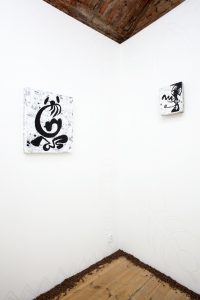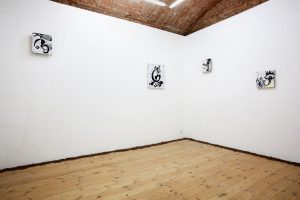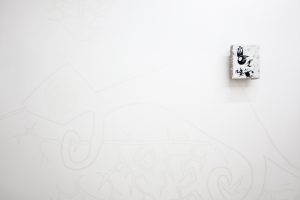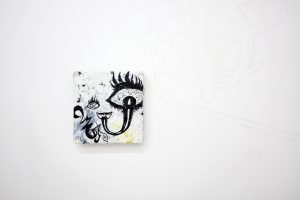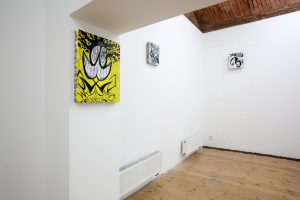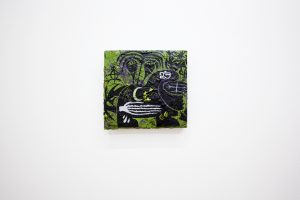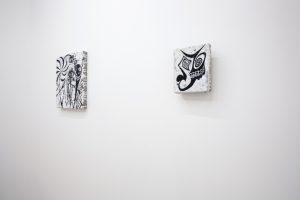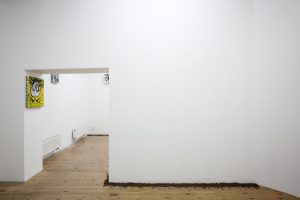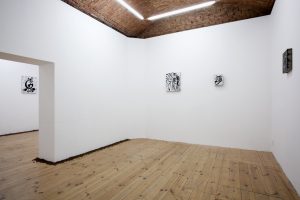15/2/ – 15/3/2019
Šimon Kadlčák’s paintings at the exhibition [indistinct chatter / distant siren wailing] consciously appropriate and loosely work with visual signs associated with the psychedelic and rave subcultures. They mediate a very specific experience that nevertheless, for those who have experienced these subcultures, is universal. As a result, it is not necessary to see the shapes and motifs in his paintings; they can also be re-experienced. They embody the experience of dissolving, of branching out in space and becoming one with our surroundings until the boundary between us and the world disappears. Besides human-vegetative metamorphoses, we also find the motif of the chameleon, which can be interpreted as symbolizing the ability to take on various forms. Within the context of the acid/rave subculture, it is a reference to ravers joined together into one collective body by their dancing where the individual is lost within the greater whole, and also to new ways of experiencing the relationship between ourselves and our surroundings. This aim of this changed consciousness is not to hide, but instead to feel an empathetic connection with the collective and to tune in to shared vibrations.
Šimon Kadlčák works with the genre spectrum of psychedelia, but uses its visual signs sensitively and conceptually. It is not just the figural motifs that organically dissolve, but also the painting’s surface and its very execution. Kadlčák explores the medium of painting by using surface structures and relief-like canvases to test its stylistic tools. The moment we see below the surface of the painting, we see how colors and structures are mixed and intertwined in a complex abstract background. On a deeper level, the splotches of color do the same as the figural and organic entities on the painting’s surface – they dissolve the boundaries between each other, becoming One.
…
Paintings are strongly intoxicating, much like addictive substances. Forms and shapes imprint certain emotions and experiences within us that burn their contours not only onto our retinas but also into our conscious and unconscious mind. Our consciousness stores these fragments of the imagination for a later time. They are forgotten, but not lost. When we again catch a fleeting glimpse of something faintly forgotten, we recall not only the painting, but also the emotional context of the situation.
Fascination is an idea in a prenatal state, unborn – an unuttered fragment of multiple possibilities. It is a kind of pre-pre-state. Fascination remains stranded in a latent interspace; it is a particular hue of light that shrouds all that is around it in a unique atmosphere but remains hidden as a source. Fascination is self-confirmation through the ability to see ourselves in someone else – to imagine. It is not a realm of existence, but delusion. Of course, this does not mean that it is any less real than ideas. Perhaps, in fact, ideas are the prenatal state of fascination. It all depends on the approach we take. All power to the imagination?
Imagination is man’s ability to create images in the mind, ideas associated with something lived, experienced. But what if we are capable of evoking images associated with someone else’s experiences? It need not necessarily be telepathy. It is enough to think about paintings and about the ways in which they use shapes to transmit experiences that transcend the limits of the personal. It is not unusual for us to see or find ourselves in paintings, to insert ourselves into them.
When I first saw Šimon Kadlčák’s sketches for the paintings in this exhibition, I had a nagging feeling that I had experienced similar shapes before. A personal experience from somewhere in the past had been drawn by someone else at some point in the future. The paintings felt like tools of synchronicity…
curated by František Fekete


